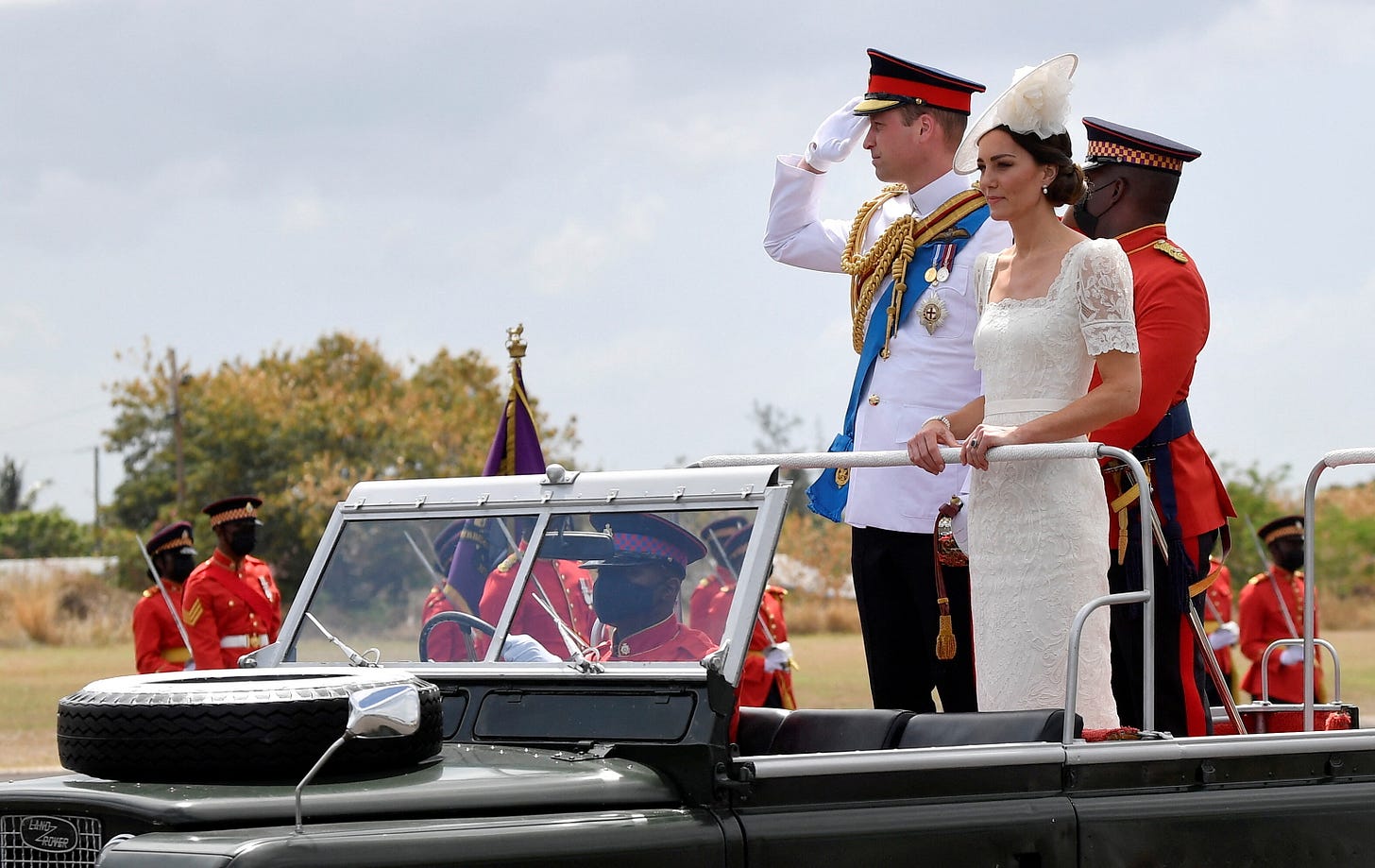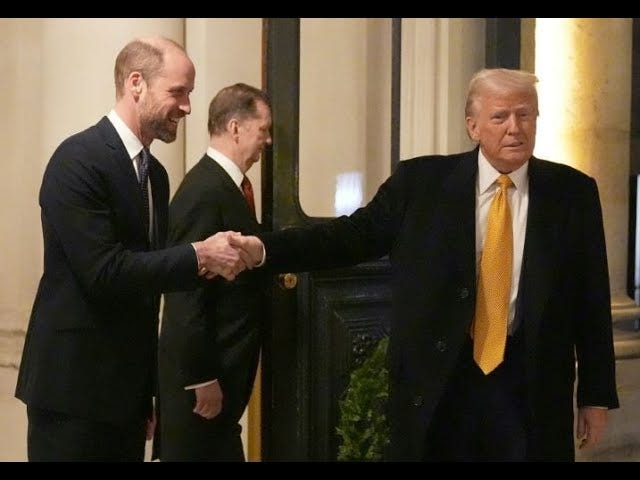When "Doing Less" is Framed as "Doing More"
shorter trips, better optics: Prince William’s team rewrites the rules of royal work
Last Friday in the paid newsletter, we discussed Prince William’s recent strategic visit to Estonia—a trip that seemed carefully calculated to position him as a global statesman:
“Keeping Everyone on Their Toes”
Prince William spent two days in Estonia this week, visiting British troops stationed at Tapa Camp as part of NATO’s Operation Cabrit. It’s not only his first visit to the country, but also his first international trip of 2025.
Now, The Sunday Times has offered some fresh insight into what William’s version of “modern monarchy” actually looks like. Spoiler: It’s less work, better optics.
William’s two-day trip to Estonia (being treated as a test case of sorts by palace aides) was short…but loaded with symbolism. He toured a military installation in camouflage and a NATO badge, posed atop a tank near the Russian border, and asked pointed questions about drone warfare and troop morale. He also met with Estonian President Alar Karis and Ukrainian refugees—even accepting a blue and yellow friendship bracelet from one student. The whole thing was polished and purposeful, capped off with William’s comment that he hoped the visit would “keep everyone on their toes.”
And that’s the whole point of this “new” foreign visit model. According to The Sunday Times, William’s team is deliberately moving away from the longer, more involved overseas tours that defined his grandmother’s reign (and seem set to continue under his father). Gone are the days of six-month Commonwealth tours and back-to-back diplomatic stops. Instead, William is opting for what aides are calling “short, sharp trips that have impact.”
In other words: less endurance, more optics.
The shift to shorter trips abroad also seems like a way to avoid diplomatic landmines while still projecting personal influence. For context, the Waleses’ last “proper” royal tour was in March 2022, when their trip to the Caribbean went down in infamy—marred by protests and awkward colonial overtones.
This was also the trip where Prince William made an attempt to address Britain’s role in the slave trade by saying the practice was “abhorrent” and “should have never happened.” He stopped short of an apology and appeased virtually nobody for his efforts. Since then, the Prince of Wales has largely stuck to domestic appearances and handshakes with world leaders whose visits to town coincide with his own. It almost reads like a trauma response.
Faced with a world that’s cooling on the idea of monarchy, it’s telling that the palace’s solution isn’t to make William more available to the public or more engaged on the world stage. The fix, apparently, is to lighten his already light workload.
And don’t get me wrong: for William, I can see the appeal. This shift to quick-hit diplomacy allows the Prince of Wales to maintain the appearance of relevance while staying close to his wife and kids—and without the logistical and political headaches that come with full-scale royal tours. A few tightly controlled photo ops, a well-timed handshake with a refugee, and a selfie with a soldier…it’s monarchy by Instagram story highlight.
The over-the-top messaging around William’s role as a “global statesman” (without the hassle of global travel) might be eye-roll-inducing, but the motivation is clear. The new framing allows Kensington Palace to prioritize “impact” over constancy…while leaving the definition of “impact” open-ended. And that’s the clever part. If success isn’t measured by the number of engagements, time spent, or ground covered, William’s team gets to define it on their own terms. A two-day trip to Estonia can be framed as a diplomatic triumph because William was photographed with civilians, soldiers, and the president. A 15-minute meeting with a head of state becomes proof of William’s growing global influence.
The bar for success isn’t just low—it’s adjustable. If William’s goal is simply to show up at strategic times, then mission accomplished. If the goal on this recent visit was to strengthen diplomatic ties with Estonia, that’s achieved too… simply because the visit happened. If the point was to support Ukraine, well, William accepted a bracelet and said the right things. Job done. There’s no real way to measure “impact” when it’s this vague, which makes it easy to frame even the most basic engagement as a win.
This also allows for strategic hedging. If things go well, William’s team can point to the trip as evidence of his growing diplomatic authority. If things go sideways…well, it was just a quick visit, after all—it’s not like he was expected to broker a peace deal or anything. This means William is never really on the hook for delivering anything concrete. He’s making an impression, not a commitment.
That’s likely why Buckingham Palace is comfortable letting William take up so much of the spotlight before taking on the top job. He gets to look like a leader without the risk that comes with real leadership; he’s firmly occupying the middle ground. It’s the perfect royal compromise: William gets to act like a statesman without the burden of statesmanship. And because “impact” is whatever the palace says it is, it’s almost impossible for him to fail.
We’ve actually already seen this model at work: with Catherine, Princess of Wales’ Early Years initiative. Framed as Kate’s “life’s work,” the project is built on soft-focus deliverables. KP has carefully positioned Kate as a leading voice on childhood development while keeping the actual scope of her project vague enough to avoid scrutiny.
There are roundtables and panel discussions, a glossy five-question survey, and beautifully produced social media campaigns—but few independent policy recommendations or tangible outcomes. What we do see in terms of outcome is often linked to existing research or government positions. And that’s by design.
By focusing on “raising awareness” rather than driving real structural change, Kate’s team has ensured that her initiative will always be seen as a success. You can’t really measure the “impact” of awareness. If one person is alerted to the importance of the early childhood years, then job well done. Time for tea.
That same strategy seems to be at play with William’s diplomatic work. If success is defined by showing up, shaking hands, and generating positive press, then William is already excelling. The palace can frame a 36-hour trip to Estonia as a diplomatic coup, or a ten-minute meeting with a world leader as “strengthening international ties.” William’s “impact” is less about what he achieves and more about how the palace packages it.
For all the talk of a modernized monarchy, the reality is that the Waleses are doing less than their predecessors—while dressing that choice up as a strategic shift. Neither William nor Catherine are out there solving problems—and they’re not really meant to. But they want some kind of credit for being changemakers, so they make sure to be seen engaging with the issues that plague our world.
In a media landscape built on perception, that’s enough to keep the press coverage glowing and the public goodwill intact—at least for now.
So far, the palace’s strategy seems to be working. William gets to project the image of a modern, impactful leader without the logistical and political headaches of traditional royal tours. But is that enough?
What do you think—does William’s new model of short, symbolic trips make sense for a modern monarchy? Or does it feel like the palace is lowering the bar? Let me know your thoughts in the comments!











They could donate some of their eye watering wealth and publicize fundraising efforts. Everyone, from poor parents and caregivers to Ukraine, would benefit. And it's so easy. I don't know why they won't do it.
That photo with Trump gets me every time. 😂